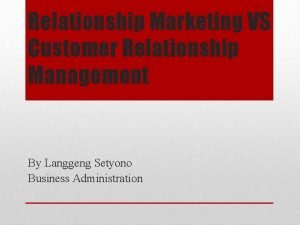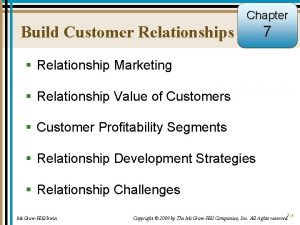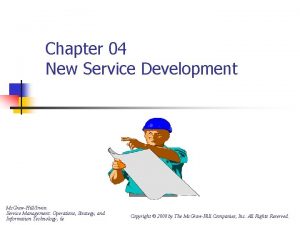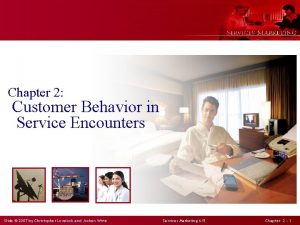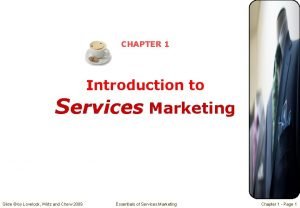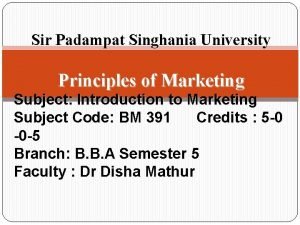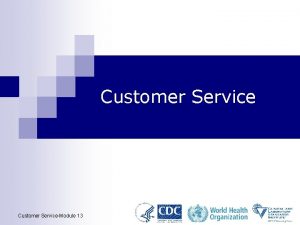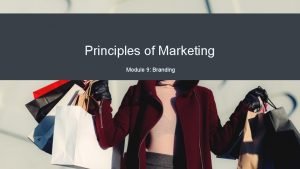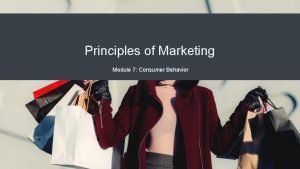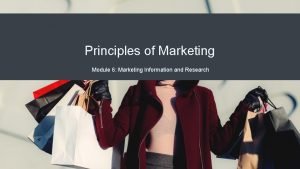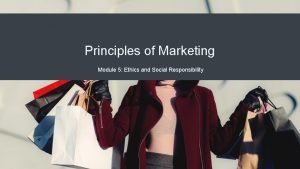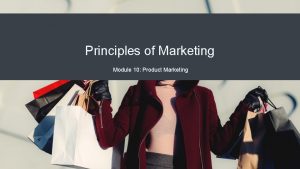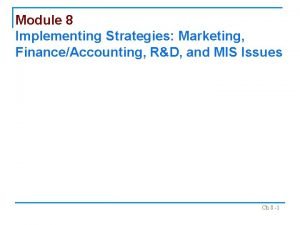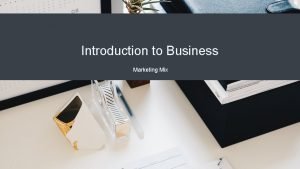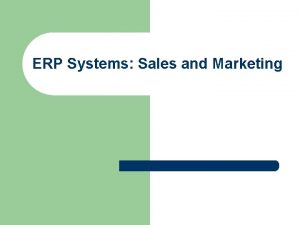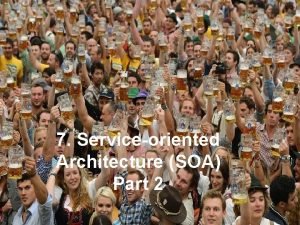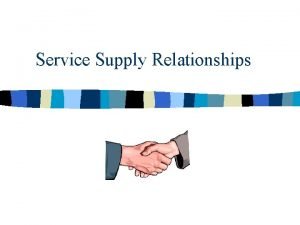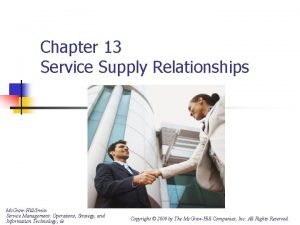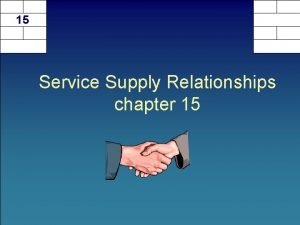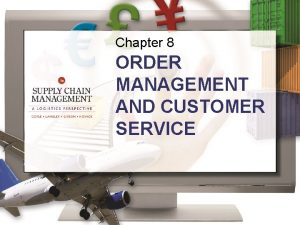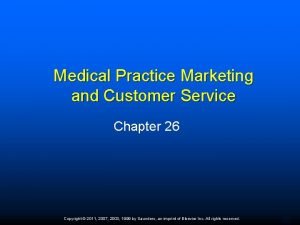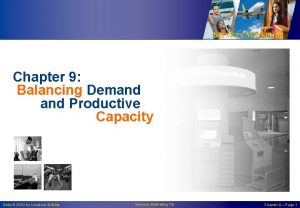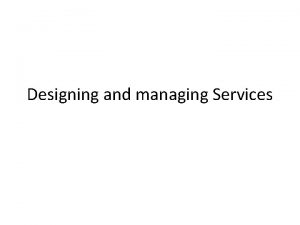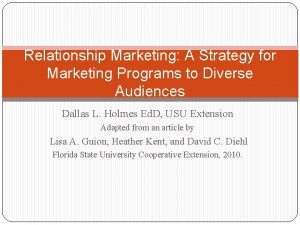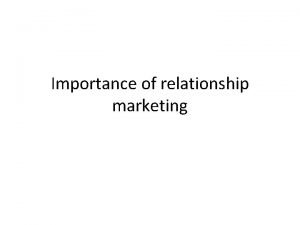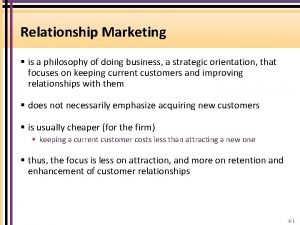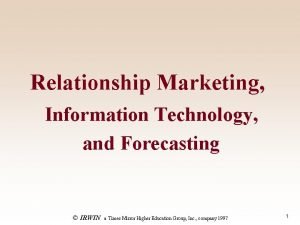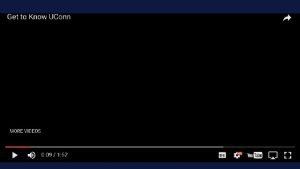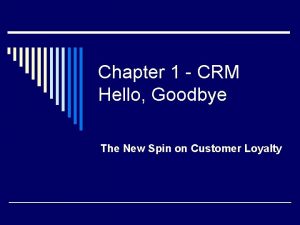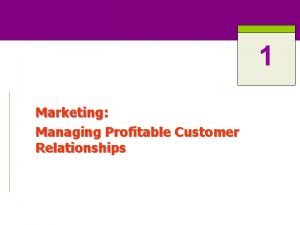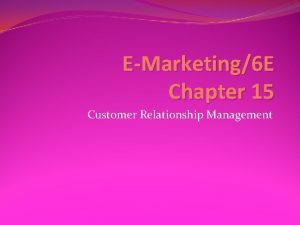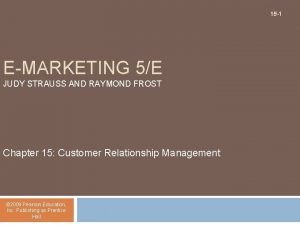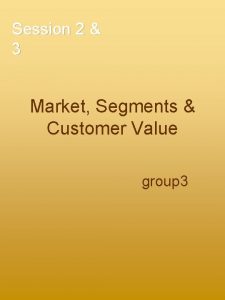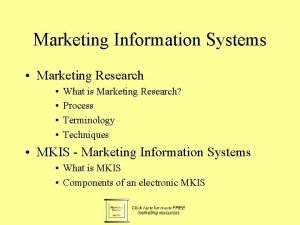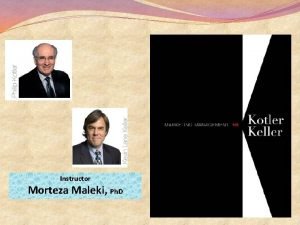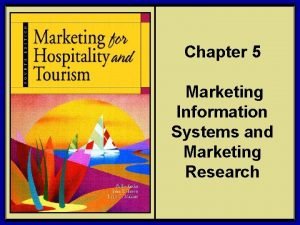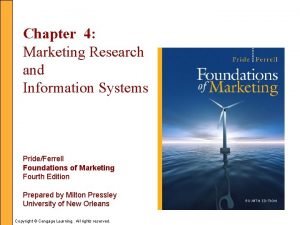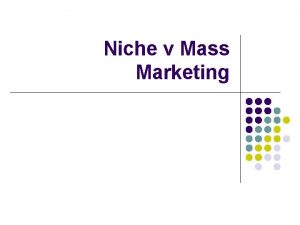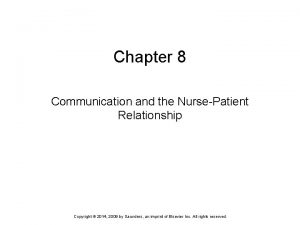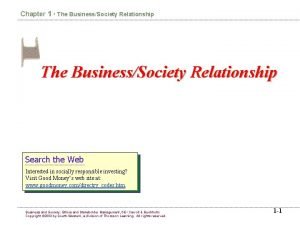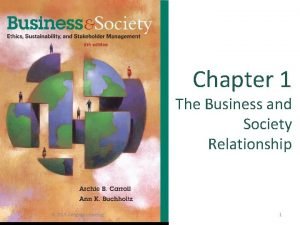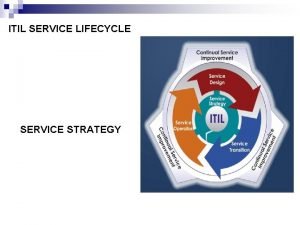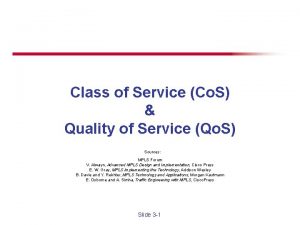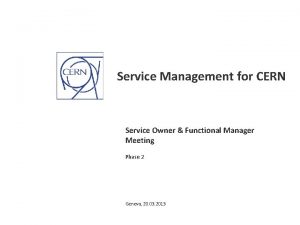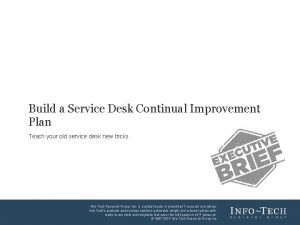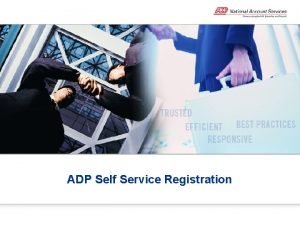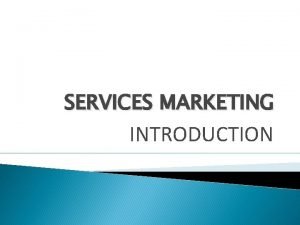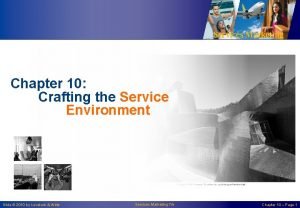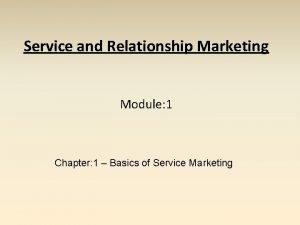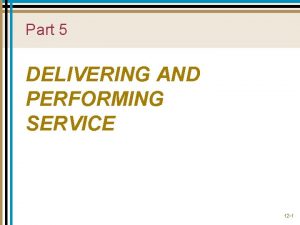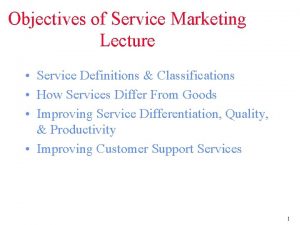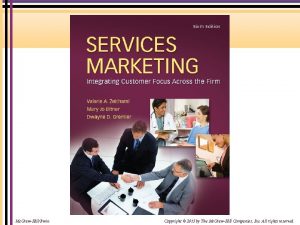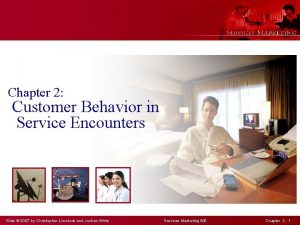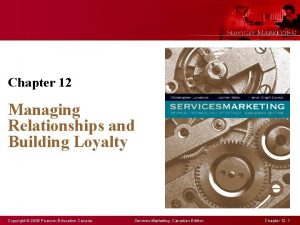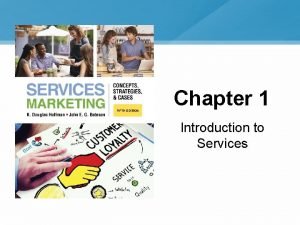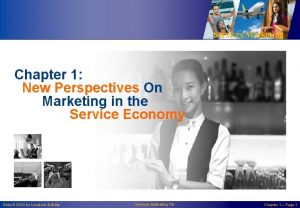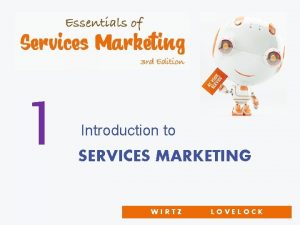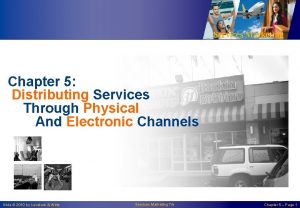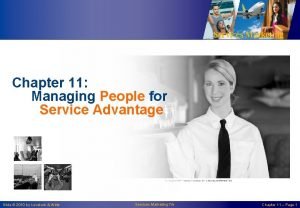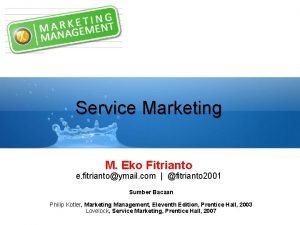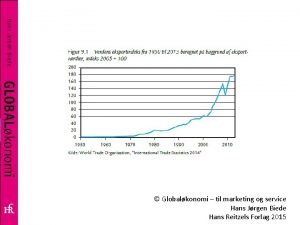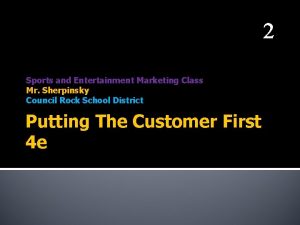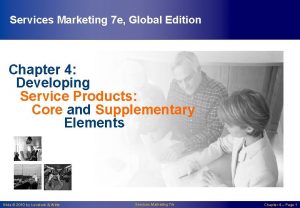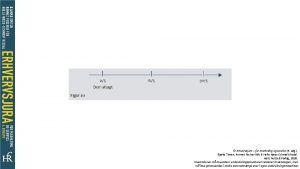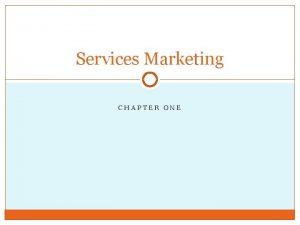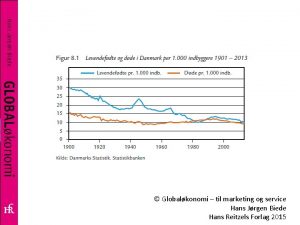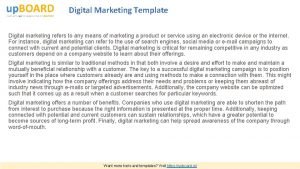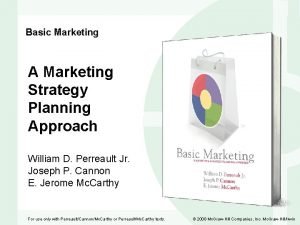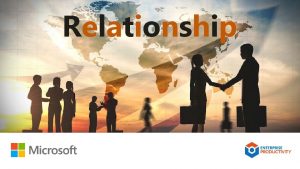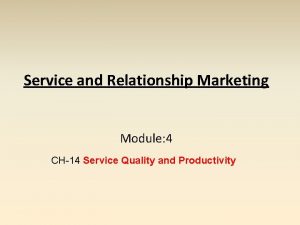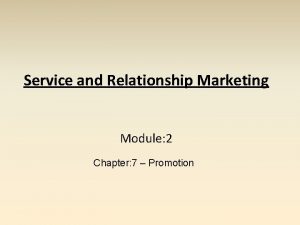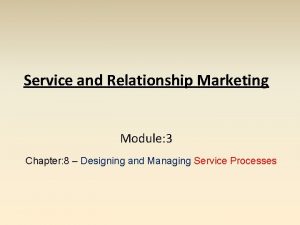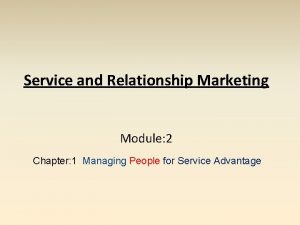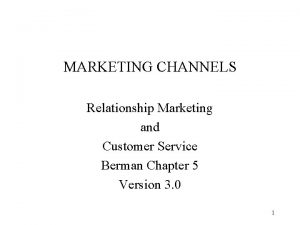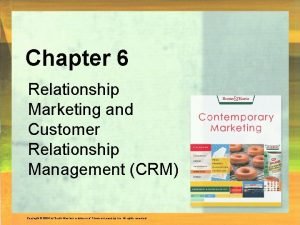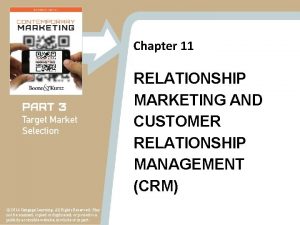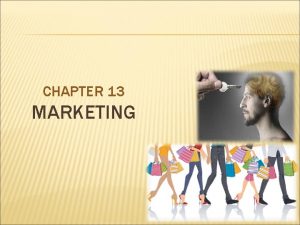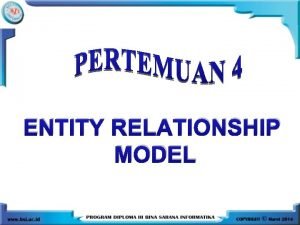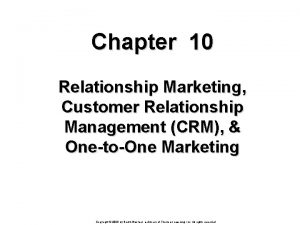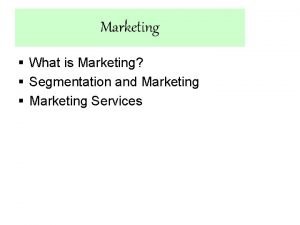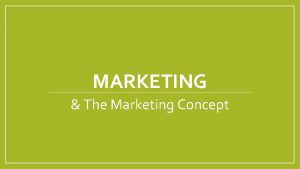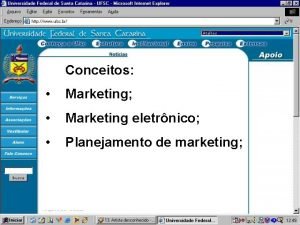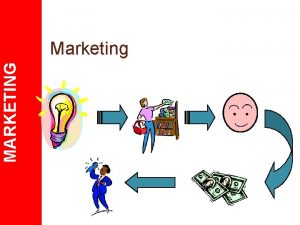Service and Relationship Marketing Module 1 Chapter 1
































































![Moments of Truth “[W]e could say that the perceived quality is realized at the Moments of Truth “[W]e could say that the perceived quality is realized at the](https://slidetodoc.com/presentation_image/70fde8f1b3db2c6e65f8c6ffe0c5f311/image-65.jpg)













- Slides: 78

Service and Relationship Marketing Module: 1 Chapter: 1 – Basics of Service Marketing

Service and Relationship Marketing Module: 1 Chapter: 1 – Basics of Service Marketing • What are services? The word service originally associated with the work performed by servants for their masters. “ the action of serving, helping or benefiting; conduct tending to the welfare or advantage of another” Services are acts, deeds, performance or efforts. The aim of service is to provide solution to the customers problem. SRM/M 1/SS

Services is an activity or series of activities take place by interaction between customer and service employees It’s an economic activity which is consumed at a time it is produced and provide added value in forms of Convenience, amusement, timeliness , comfort or health SRM/M 1/SS

Services Defined… “Activities, Benefits or Satisfactions which are offered for sale or provided in connection with the sale of goods” American Marketing Association SRM/M 1/SS

Services Defined… “Separately identifiable, intangible activities which provide want satisfaction when marketed to consumers and/or industrial users and which are not necessarily tied to the sale of a product or another service” William J. Stanton SRM/M 1/SS

Services Defined… “Any activity or benefit that one party can offer to another that is essentially intangible and does not result in the ownership of anything. Its production may or may not be tied to a physical product” Philip Kotler and Bloom SRM/M 1/SS

Why Services Marketing ? ? ? Goods Vs. Services • Goods are tangible • Services are intangible • Goods are homogeneous • Services are heterogeneous • Goods are produced in the factory • Services are produced in buyerseller interactions • Production, distribution and consumption are separate and independent functions in goods • Production, distribution and consumption take place simultaneously in the case of services SRM/M 1/SS

Goods Vs. Services • Consumers do not generally participate in the production of goods • Consumers are coproducers in services • Services can not be stored • Goods can be stored • In sale of goods, transfer of ownership takes place • In the sale of services, transfer of ownership will not take place SRM/M 1/SS

Characteristics of Services… • • • Intangibility Inseparability Variability Perishability Customer participation No ownership SRM/M 1/SS

Intangibility… • Challenges : - Cannot be communicated easily - Consumer suspects due to absence of concrete evidences - Design of total service package not possible - Comparative presentation is not possible • Strategic Options : - Making the service process tangible to the maximum possible extent - Managing and promoting word-of-mouth communication - Strengthening internal and external marketing - Use of Relationship Marketing SRM/M 1/SS

Inseparability… • Challenges : • Strategic Options : - Problems of market expansion - Maintenance of service quality - Compulsory presence of consumer - Limited production capacity - Operation at limited capacity - Minimization of customer interactions - Innovating techniques of indirect interaction - Standardization to the maximum possible extent - Developing distribution network with quality control mechanisms SRM/M 1/SS

Variability… • Challenges : • Strategic Options : - Limited scope for standardization - Not possible to communicate exactly what the consumer is going to receive - Quality can be determined only after the service is consumed - More focus on standardization - Internal marketing and employee training - Positioning variation as a strength of innovation - Promote research and innovation SRM/M 1/SS

Perishability… • Challenges : - Storage of service is not possible - Sales volume continuously in relation to the capacity - Time pressure in sales • - SRM/M 1/SS Strategic Options : Demand management Capacity management Tactical approaches Continuous study on demand patterns and competitive parameters

Customer Participation… • Challenges : • Strategic Options: - Customers are not controllable - Production quality also depends upon customer’s knowledge and ability to participate - Customers are evaluating at every stage of service production - Effective external marketing - Customer education and training - Effective interactive marketing - Management of movements of truth - Effective internal marketing SRM/M 1/SS

No ownership… • Challenges: • Strategic Options: - Nothing remains after consumption - Very less time to the consumer to evaluate the product - High consumer dissonance - Making communication tangible - Customer relationship marketing - Managing high level of company image SRM/M 1/SS

Sources for service sector growth Ø Innovation -: Push Theory of Innovation -: Pull theory of Innovation Ø Social Trends SRM/M 1/SS

Reasons for Growth in Services Sector… Ø Growth in intermediate demand from firm Ø Growth in final demand from customers • • • Increase in affluence More leisure time Working woman Growth in population of DINKS Greater life expectancy Greater complexity of products Greater complexity in life Greater concern for resource scarcity and ecology Increasing number of new products SRM/M 1/SS

Service Sector in Indian Economy…

SRM/M 1/SS

Reasons for growth of Services in India… • • • Economic Affluence Changing Role of Women Cultural Changes IT Revolution Development of Markets Unbundling Corporations Increasing Consciousness of Health Care Economic Liberalization Migration Export Potential Service Tax SRM/M 1/SS

Factors Stimulation the transformation of the Service Economy Ø Government Policies Ø Ø Change in regulation Privatization New rules to protect customer, employees and the environment New agreements on trade in services Ø Social Changes Ø Rising consumer Expectation Ø Ø More affluence More people short of time Increased desire for buying experience vs things Rising consumer ownership of computer, cell phones, and high tech equipments SRM/M 1/SS

Ø Rising consumer ownership of computer, cell phones, and high tech equipments Ø Easier access to more information Ø Immigration Ø Gewoning but aging population Ø Business Trends Ø Ø Ø Ø Push to increase shareholders value Emphasis on productivity and cost saving Manufacturera add value through service and sell services More strategic alliances and outsourcing Focus on quality and customer satisfaction Growth of franchising Marketing emphasis by nonprofits SRM/M 1/SS

Ø Advance in Information Technology Ø Ø Ø Growth of Internet Greater bandwidth Compact Mobile Equipment Wireless networking Faster, more powerful software Digitization of text, graphics, audio and video Ø Globalization Ø Ø Ø More companies operation on transnational basis Increased international Travel International merger and acquisitions, JV’s ‘Off shoring’ of customer service Foreign competitors invade domestic markets SRM/M 1/SS

Role (Type) of Services in Economy Ø Value Added Services Financing, Leasing, Insurance Ø Infrastructure service Communications, Transportation, Utilities, Banking Ø Manufacturing Services inside company Finance, Accounting, Legal , R&D and design Ø Distribution service Wholesaling, Retailing, Repairing Ø Personal Service Health care, Restaurants, Hotels Ø Business Service supporting Manufacturing Consulting, Auditing, Advertising, Waste Disposal Ø Governments Service Military, Education, Judicial, Police and fire protection SRM/M 1/SS

Service Classification : Service process Matrix Degree of Interaction and Customization Degree of Labor intensity LOW High Service factory Service Shop • Airlines • Trucking • Hotels • Resorts & Recreation • Hospitals • Auto Repair • Other repair services Mass services Professional Services • Retailing • Wholesaling • School • Retail aspect of commercial Banking • Physicians • Lawyers • Accountants • Architects SRM/M 1/SS

How to win customer in Service Business(USP’s) • Availability How accessible is the service? (ATM’s – service beyond the traditional banker’s hours) • Convenience (The location of service where customer must travel to that service-Fast food restaurants) • Dependability Hoe reliable is the service? (Airlines- on time departure & arrival performance will build huge trust) • Personalization need for Customization -Are you treated as an individual? SRM/M 1/SS

• Price The price is viewed as being a surrogate for quality. • Quality is judged by both the process of services delivery and the put comes of the service. It is difference between service expectation & service experience • Reputation Unlike a product, a poor service experience can note exchanged or returned for a different model. Positive word-of-mouth is the most effective form of advertising. • Safety In air travel and medicine, the customers are putting their lives in the hands of the service provider • Speed How long must I wait for service? For emergency service such as fire or police protection, response time is the major criterion of performance. SRM/M 1/SS

Technology in Services The introduction of technology often empowers the customer to perform the service unassisted. For, example , the credit card reader at the pump facilitates the purchase of a gasoline without help and Internet allows customer to book their own flights SRM/M 1/SS

• Technology in Service Encounter Advances in communication and information technology are having profound effect on ways customers interface with service providers. There are five modes of technology’s contribution to the service encounter. (A) Technology free service encounter where the customer is in physical proximity to and interacts with a human service provider. This mode represents the traditional high-touch service in which technology does not pay a direct role. Such as Saloon, hair dresser, tailor TECHNOLOGY CUSTOMER SERVER SRM/M 1/SS

(B)Technology-assisted service encounter Here only the service provider has access to the technology to improve the quality of face to face service. A health care service performed by technology which is operated by only professionals TECHNOLOGY CUSTOMER SERVER SRM/M 1/SS

(C)Technology- facilitated service encounter Here both the customer and service provider have access to the same technology. For example a financial planner in consultation with a client can refer to a financial model on a personal computer to illustrate projected returns for different risk profiles TECHNOLOGY SERVER CUSTOMER SRM/M 1/SS

(D)Technology-meditated service encounter The customer and human service provider are not physically together and thus the service encounter no longer is the traditional face to face contact. Its about Getting technical help on a distance call. Example GPS services or services provided by Just dial. TECHNOLOGY CUSTOMER SERVER SRM/M 1/SS

(E)Technology-generated service encounter Human service provider is replaced entirely with technology that allows the customer to self-service. It reduces the cost of service delivery For Example bank ATM’s, website based information, e-commerce TECHNOLOGY CUSTOMER SERVER SRM/M 1/SS

The Emergence of Self Service Elimination of labor costs for nonproductive activity is the principle driver for the service provider. Customer acceptance results from increased opportunity for customization, accuracy, convenience and speed. Cost saving and place & Time has lead the buisiness to become Self Service by customer him/herself. SRM/M 1/SS

Evolution of Self Service Industry Human Contact Machine-Assisted Electronic Service Banking Teller ATM Grocery Checkout Clerk Airlines Ticket Agent Self-check out station Check in kiosks Restaurants Wait person Movie theater Ticket sale Book store Information clerk Stock-availability terminal Online shopping Education Teacher Distance Learning Gambling Poker dealer Online Banking Online order/pick up Print boarding pass Vending machine Online order/delivery Kiosk Ticketing Pay-for-view Computer Tutorial Computer Poker SRM/M 1/SS Online poker

Automation in Services Automation means replacing human manual activity by the machine. for Example: -an automatic lawn sprinkler system a hotel -automated answering systems that route callers by means of Touch -Tone pones like Toll free or customer care services of the service provider David A Collier has suggested following automation categories 1. Fixed sequence (F) A machine that repetitively performs successive steps in a given operation according to a predetermined sequence, condition and position and whose set information cannot be changed easily. E. g. automatic parking lot gate 2. Variable sequence(V) A machine same as fixed sequence robot but whose set information can be changed easily. E. g. automated teller machine SRM/M 1/SS

3. Playback(P) A machine that can produce operation from memory that were originally executed under human control. E. g. telephone answering machine 4. Numerical Controlled(N) A machine that can perform task according to sequence as command by stored information tat can be reprogrammed easily. E. g. animated character at an amusement park. 5. Intelligent(I) A machine with sensory perception devices, such as visual or tactile receptors, that can detect changes in the work environment or task by itself and has its own decision-making abilities. E. g. autopilot for a commercial airplane SRM/M 1/SS

6. Expert system(E) A computer program that uses an inference engine (e. g. decision rules) and a knowledge base (i. e. information on a particular subject) to diagnose problem ex- maintenance trouble shooting for elevator repair 7. Totally automated system(T) A system of machine and computers that performs all the physical and intellectual tasks that are required to produce or deliver a service. ex- electronic fund transfer SRM/M 1/SS

Internet Services Websites can be used in many different ways Ø Ø Ø Ø As a channel to sell a product or service (amazone. com, wine. com) As a supplemental channel (online booking of order) For technical support (dell. com, nike. com) To Embellish existing service (HBR cases & Research paper) To convey information (Dr. Koop, wikipedia) To communicate with Membership To play Games Internet Models Ø Ø Ø Ø Internet Access Provider Portal Information content Online Retailer Transaction Enablers Market Makers SRM/M 1/SS

Comparison of Electronic and Traditional Services Features Electronic Service Traditional Service Encounter Screen to face Face to Face Availability Anytime Standard Working Hour Access From home Travel to location Market Area Worldwide Local Ambiance Electronic Interface Physical Environment Competitive Differentiation Convenience Personalization Privacy Anonymity Social interaction SRM/M 1/SS

E-Business Models Peter Weill and Michael Vitale have described eight generic ebusiness models . Content Provider Provides content such as information, digital products and services. Ex. Reuters, a British news agency Direct to customer Provides goods & services directly to the customer, often bypassing traditional retail channel memebers. Ex-Dell computer Full service Provider Provide full range of service in one domain directly. E. g. financial, health, indusyrial chemicals. Ex – General Electric Supply I SRM/M 1/SS

Intermediary Brings together buyers and sellers by concentrating information. Ex-e. Bay Shared Infrastructure Brings together multiple competitors to cooperate by sharing common IT infrastructure. An example is SABRE reservation system for airlines. Value Net Integrator Coordinates activities across the value net by gathering, synthesizing, and distributing information. Ex 7 -eleven Japan Virtual Community Created & facilitates online community of people with Monster. com, the job-placement service firm. Whole-of-Enterprise Provides a firm wide single point of contact, consolidating all services provides by a large multiunit organization. An example is the U S federal government SRM/M 1/SS

Managing the New Technology Adoption Process Orientation & Education Technology opportunity Analysis Application requirements analysis Functional specification Design specification Managing the New Technology Adoption Review of Results Testing of technology Implementation Planning Implementation SRM/M 1/SS Equipment selection and contract commitments

8 p’s of Services Marketing Mix Product elements - the core and periphery service elements at the centre of the company's marketing strategy; Place and Time - delivering product elements to customers can be done physically and/or electronically, depending upon the service. Speed and convenience are essential to the customer and are important valueadds; Price and Other User Outlays - pricing is only a part of what customers may part with when purchasing a service; one must also consider time and convenience; Promotion and Education - speaks for itself, but the marketer must make sure communications not only provide information, but also persuade the customer of the service's relevance to the customer's particular 'problem'; SRM/M 1/SS

Process - the means by which the firm delivers product elements; People - front-line staff will have a direct impact on perceptions; and Physical Environment - the appearance of the place where the services are delivered may have a significant impact upon whether the service was satisfactory; Productivity and Quality - improving productivity is a requisite in cost management; but quality, as defined by the customer, is essential for a service to differentiate itself from other providers. SRM/M 1/SS

Service and Relationship Marketing Module: 1 Chapter: 2 – Customer Behavior in Service Encounter Four Broad Categories of Service- A Process Perspective In service, people, physical objects, and data can be processed , and the nature of the processing can be tangible or intangible. Tangible actions are performed on people’s bodies or to their physical possession. Intangible actions are performed on people’s minds or to their intangible assets. This gives rise to classification of services into four broad categories. They are People processing Possession processing Mental stimulus processing Information processing SRM/M 1/SS

Who or What is the Direct Recipient of the service ? Nature of the Service Act People Possessions Tangible Actions People-processing (services directed to people’s bodies): ØPassenger Transportation, ØLodging ØHealth care Possession-processing (Services directed at physical possessions) ØFreight transportation ØRepair and Maintenance ØLaundry and dry cleaning Intangible Actions Mental Stimulus processing (service directed at people’s mind): ØEducation ØAdvertising/PR ØPsychotherapy Information Processing (services directed at intangible assets) ØAccounting ØBanking ØLegal services SRM/M 1/SS

The Three Stage Model of Service Consumption/ Customer Decision Making Pre-purchase Stage Service Encounter Stage Post-encounter Stage SRM/M 1/SS

Pre-purchase Stage

Pre-purchase Stage Overview Pre-purchase Stage Service Encounter Stage Post-encounter Stage • Customers seek solutions to aroused needs • Evaluating a service may be difficult • Uncertainty about outcomes Increases perceived risk • What risk reduction strategies can service suppliers develop? • Understanding customers’ service expectations • Components of customer expectations • Making a service purchase decision

Need Arousal • Decision to buy or use a service is triggered by need arousal • Triggers of need: – Unconscious minds (e. g. , personal identity and aspirations) – Physical conditions (e. g. , hunger ) – External sources (e. g. , a service firm’s marketing activities) • Consumers are then motivated to find a solution for their need Courtesy of Masterfile Corporation

Information Search • Need arousal leads to attempts to find a solution • Evoked set – a set of products and brands that a consumer considers during the decision-making process – that is derived from past experiences or external sources • Alternatives then need to be evaluated before a final decision is made

Evaluating Alternatives – Service Attributes • Search attributes help customers evaluate a product before purchase – E. g. , type of food, location, type of restaurant and price • Experience attributes cannot be evaluated before purchase – The consumer will not know how much s/he will enjoy the food, the service, and the atmosphere until the actual experience • Credence attributes are those that customers find impossible to evaluate confidently even after purchase and consumption – E. g. , hygiene conditions of the kitchen and the healthiness of the cooking ingredients

How Product Attributes Affect Ease of Evaluation Most Goods Easy To Evaluate Most Services Difficult To evaluate Clothing Restaurant Computer Chair Meals Repair Motor Lawn Fertilizer Education Vehicle Haircut Legal Services Foods High In Search Attributes Entertainment High In Experience Attributes Complex High In Surgery Credence Attributes Source: Adapted from Valarie A. Zeithaml , “How Consumer Evaluation Processes Differ Between Goods & Services, ” in J. H. Donelly and W. R. George, Marketing of Services (Chicago: American Marketing Association, 1981)

Perceived Risks of Purchasing and Using Services • Functional – unsatisfactory performance outcomes • Financial – monetary loss, unexpected extra costs • Temporal – wasted time, delays leading to problems • Physical – personal injury, damage to possessions • Psychological – fears and negative emotions • Social – how others may think and react • Sensory – unwanted impact on any of five senses

How Might Consumers Handle Perceived Risk? • Seek information from respected personal sources • Compare service offerings and search for independent reviews and ratings via the Internet • Relying on a firm with good reputation • Looking for guarantees and warranties • Visiting service facilities or going for trials before purchase and examining tangible cues or other physical evidence • Asking knowledgeable employees about competing services

Strategic Responses to Managing Customer Perceptions of Risk Free trial (for services with high experience attributes) Advertise (helps to visualize) Display credentials Use evidence management (e. g. , furnishing, equipment etc. ) Offer guarantees Encourage visit to service facilities Give customers online access about order status

Understanding Customers’ Service Expectations • Customers evaluate service quality by comparing what they expect against what they perceive – Situational and personal factors also considered • Expectations of good service vary from one business to another, and differently positioned service providers in same industry • Expectations change over time

Factors Influencing Customer Expectations of Service Source: Adapted from Valarie A. Zeithaml, Leonard A. Berry, and A. Parasuraman, “The Nature and Determinants of Customer Expectations of Service, ” Journal of the Academy of Marketing Science 21, no. 1 (1993): 1 -12

Components of Customer Expectations Desired Service Level • wished-for level of service quality that customer believes can and should be delivered Adequate Service Level • minimum acceptable level of service Predicted Service Level • service level that customer believes firm will actually deliver Zone of Tolerance • Acceptable range of variations in service delivery

Purchase Decision • Purchase Decision: Possible alternatives are compared and evaluated, whereby the best option is selected – Simple if perceived risks are low and alternatives are clear – Complex when trade-offs increase • Trade-offs are often involved • After making a decision, the consumer moves into the service encounter stage

Service Encounter Stage

Service Encounter Stage - Overview Pre-purchase Stage ● Service encounters range from high- to low-contact ● Understanding the servuction system Service Encounter Stage ● Theater as a metaphor for service delivery: An integrative perspective è Service facilities è Personnel Post-encounter Stage è Role and script theories

Service Encounter Stage • Service encounter – a period of time during which a customer interacts directly with the service provider – Might be brief or extend over a period of time (e. g. , a phone call or visit to the hospital) • Models and frameworks: 1. 2. 3. 4. “Moments of Truth” – importance of managing touchpoints High/low contact model – extent and nature of contact points Servuction model – variations of interactions Theater metaphor – “staging” service performances
![Moments of Truth We could say that the perceived quality is realized at the Moments of Truth “[W]e could say that the perceived quality is realized at the](https://slidetodoc.com/presentation_image/70fde8f1b3db2c6e65f8c6ffe0c5f311/image-65.jpg)
Moments of Truth “[W]e could say that the perceived quality is realized at the moment of truth, when the service provider and the service customer confront one another in the arena. At that moment they are very much on their own… It is the skill, the motivation, and the tools employed by the firm’s representative and the expectations and behavior of the client which together will create the service delivery process. ” Richard Normann

Service Encounters Range from High-Contact to Low-Contact

Distinctions between High-Contact and Low-Contact Services • High-Contact Services – Customers visit service facility and remain throughout service delivery – Active contact – Includes most people-processing services • Low-Contact Services – Little or no physical contact – Contact usually at arm’s length through electronic or physical distribution channels – Facilitated by new technologies

The Servuction System Source: Adapted and expanded from an original concept by Eric Langeard and Pierre Eiglier

The Servuction System: Service Production and Delivery • Servuction System: visible front stage and invisible backstage • Service Operations – Technical core where inputs are processed and service elements created – Contact people – Inanimate environment • Service Delivery – Where “final assembly” of service elements takes place and service is delivered – Includes customer interactions with operations and other customers

Theater as a Metaphor for Service Delivery William Shakespeare As You Like It

Theatrical Metaphor: an Integrative Perspective Good metaphor as service delivery is a series of events that customers experience as a performance Service facilities Personnel • Stage on which drama unfolds • This may change from one act to another • Front stage personnel are like members of a cast • Backstage personnel are support production team Roles Scripts • Like actors, employees have roles to play and behave in specific ways • Specifies the sequences of behavior for customers and employees

Implications of Customer Participation in Service Delivery • Greater need for information/training – Help customers to perform well, get desired results • Customers should be given a realistic service preview in advance of service delivery – This allows them to have a clear idea of their expected role and their script in this whole experience – Manages expectations and emotions

Post-Encounter Stage

Post-purchase Stage Overview Pre-purchase Stage ● Evaluation of service performance Service Encounter Stage Post-encounter Stage ● Future intentions

Customer Satisfaction with Service Experience • Satisfaction: attitude-like judgment following a service purchase or series of service interactions – Whereby customers have expectations prior to consumption, observe service performance, compare it to expectations • Satisfaction judgments are based on this comparison – Positive disconfirmation (better) – Confirmation (same) – Negative disconfirmation (worse)

Customer Delight: Going Beyond Satisfaction • Research shows that delight is a function of three components – Unexpectedly high levels of performance – Arousal (e. g. , surprise, excitement) – Positive affect (e. g. , pleasure, joy, or happiness) • Strategic links exist between customer satisfaction and corporate performance – By creating more value for customers (increased satisfaction), the firm creates more value for the owners

Customer Delight: Going Beyond Satisfaction • Best Practice in Action 2. 1: Progressive Insurance Delights Its Customers – Provided excellent customer service which allowed them to lower costs and also increase customer satisfaction and retention

Summary • Pre-purchase Stage Service Encounter Stage Key Steps 1. Need arousal 2. Information search 3. Evaluation of alternative solutions 4. Purchase decision • Customers face perceived risks which marketers should reduce with some strategic responses • Zone of tolerance: Adequate to desired. Dissatisfaction if service level falls below adequate level. • Moments of Truth: importance • Servuction model – variations of effectively managing touchpoints • High/low contact service model of interactions • Theater metaphor – “staging” service performances – understanding the extent and nature of contact points • In evaluating service Post-encounter Stage performance, customers can have expectations positively disconfirmed, or negatively disconfirmed • Unexpectedly high levels of performance, arousal, and positive affect are likely to lead to delight
 Principles of marketing grade 11 module 2
Principles of marketing grade 11 module 2 Difference between rm and crm
Difference between rm and crm Pyramid of relationships in crm
Pyramid of relationships in crm New service development process cycle
New service development process cycle C device module module 1
C device module module 1 Post encounter stage in service marketing
Post encounter stage in service marketing Service marketing chapter 1
Service marketing chapter 1 Three considerations of societal marketing concept
Three considerations of societal marketing concept Customer service module
Customer service module Principles of marketing module 9
Principles of marketing module 9 Principles of marketing quarter 2 -- module 7
Principles of marketing quarter 2 -- module 7 Principles of marketing quarter 2 module 6
Principles of marketing quarter 2 module 6 Principles of marketing module 5
Principles of marketing module 5 Principles of marketing module 10
Principles of marketing module 10 Principles of marketing module 8
Principles of marketing module 8 Marketing mix module
Marketing mix module Marketing module in erp
Marketing module in erp Perceived service alternative
Perceived service alternative Service provider and service consumer
Service provider and service consumer Bidirectional service supply relationship
Bidirectional service supply relationship Service supply relationships
Service supply relationships Bidirectional service supply relationship
Bidirectional service supply relationship Order management & customer service relationship concept
Order management & customer service relationship concept Medical practice marketing and customer service
Medical practice marketing and customer service Balancing demand and capacity in service marketing
Balancing demand and capacity in service marketing Nature of service marketing
Nature of service marketing Relationship marketing programs
Relationship marketing programs Importance of relationship marketing
Importance of relationship marketing Core service provision
Core service provision Meaning of relationship marketing
Meaning of relationship marketing Relationship marketing continuum
Relationship marketing continuum Meaning of relationship marketing
Meaning of relationship marketing Meaning of relationship marketing
Meaning of relationship marketing Marketing is managing profitable customer relationship
Marketing is managing profitable customer relationship Define the relationship chapter 15
Define the relationship chapter 15 5 e's of relationship marketing
5 e's of relationship marketing Finer segmentation strategies
Finer segmentation strategies Marketing information systems and marketing research
Marketing information systems and marketing research Define marketing information management
Define marketing information management Marketing information systems and marketing research
Marketing information systems and marketing research Marketing information systems and marketing research
Marketing information systems and marketing research Marketing information systems and marketing research
Marketing information systems and marketing research Advantages and disadvantages of niche marketing
Advantages and disadvantages of niche marketing Chapter 8 communication and the nurse patient relationship
Chapter 8 communication and the nurse patient relationship Chapter 1 the business and society relationship
Chapter 1 the business and society relationship Chapter 1 the business and society relationship
Chapter 1 the business and society relationship Itil service lifecycle service transition
Itil service lifecycle service transition Itil phases
Itil phases 8 step improvement
8 step improvement Mpls class of service
Mpls class of service Service owner vs service manager
Service owner vs service manager Help desk improvement plan
Help desk improvement plan Adp self service canada
Adp self service canada Servuction model in service marketing
Servuction model in service marketing Service environment
Service environment Servuction model in service marketing
Servuction model in service marketing Inverted services marketing triangle
Inverted services marketing triangle Service marketing objectives
Service marketing objectives Inverted service marketing triangle
Inverted service marketing triangle Post encounter stage
Post encounter stage Wheel of loyalty
Wheel of loyalty Health and safety images free download
Health and safety images free download Price fences marketing
Price fences marketing New perspective marketing
New perspective marketing Four broad categories of services
Four broad categories of services Marketing chapter 5
Marketing chapter 5 People in service marketing
People in service marketing Three types of marketing in service industries
Three types of marketing in service industries Globaløkonomi til marketing og service pdf
Globaløkonomi til marketing og service pdf Sports and entertainment marketing class
Sports and entertainment marketing class Flower of service marketing
Flower of service marketing Erhvervsjura for marketing og service
Erhvervsjura for marketing og service Book review assignment
Book review assignment Tangibility spectrum in service marketing
Tangibility spectrum in service marketing What is service branding in marketing
What is service branding in marketing Globaløkonomi til marketing og service
Globaløkonomi til marketing og service A market refers to:
A market refers to: Digital marketing marketing refers
Digital marketing marketing refers Universal functions of marketing
Universal functions of marketing

